
Ed Mathez has collected rocks from the tops of volcanoes to the bottom of the ocean. Find out how he became a geologist and what we can learn from studying rocks.

Ed Mathez has collected rocks from the tops of volcanoes to the bottom of the ocean. Find out how he became a geologist and what we can learn from studying rocks.
1. Why did you become a geologist?
Ed Mathez: When I was 18 years old, I went to Montana and saw spectacular mountains. I wandered around the mountains to try to figure out how they formed.
My mother was actually a geologist, so she probably inspired me without my knowing it. She worked for an oil company, helping them decide where to look for minerals in the deep sea . When I was young, she took me occasionally to old rock quarries to look for fossils and minerals.
When I went to college, I wanted to study history. But some great teachers inspired me to switch to studying Earth .
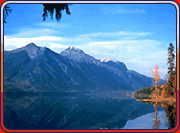
How did Montana's mountains form?
2. What's so cool about rocks?
Ed: I don't know if there's anything particularly cool about rocks themselves. What's cool are the things that rocks can tell you when you look closely at them. Rocks can tell you something about the history of an area, like how a mountain became a mountain.
Rocks can also help answer larger questions about Earth's history, such as how it has changed over time. Earth is sort of like your body. It has all kinds of different parts that work together and affect each other. We call this a system. The Earth system is always changing, and the interaction between all of its parts is very complicated. Rocks can tell us how the different parts of Earth work. That's what makes rocks so cool.
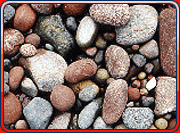
Each rock has a story to tell.
3. What do you want every kid to know about Earth?
Ed: I think kids should know that Earth changes constantly. It's a very complex system, just like your own body. All of its parts are interacting all the time, and the system works amazingly well.
Unfortunately, sometimes people change the environment on Earth in ways that could potentially hurt the system, and us, greatly. So we have to take care of the place where we live. For example, we can conserve Earth's natural resources by recycling newspapers and not wasting water .
Earth is the only planet we have. We have to protect it.
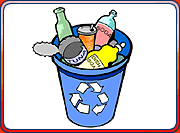
We can protect our planet by recycling.
4. What are you researching now?
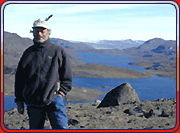
In Greenland, Ed is studying some of the oldest rocks on Earth.
Ed: Lately, I've been studying very old rocks in Greenland.
Earth is old, about 4.5 billion years old. There are rocks in Greenland that are 3.8 billion years old. These are some of the oldest rocks on Earth.
I'm hoping that these rocks will give me clues about whether or not life existed at that time. It's tricky because the rocks are in a completely different form from what they once were. They were buried in Earth and heated several times in the past, which changed their form. But because these rocks are so old, they hold unique stories about the past.
5. What do you find out?
Ed: We wrestle with all sorts of questions, such as:
- What was the early Earth like when it first formed 4.5 billion years ago?
- Why does Earth look the way it does?
- How did Earth become habitable for creatures like ourselves?
- How does the interior of Earth work?
- What causes changes in Earth's climate ?
These are big, complicated questions. A scientist might spend his whole career trying to answer just one little tiny part of one of them.
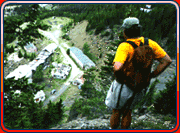
Scientists gather evidence in the field to help answer these questions.
6. Why do you collect rocks?
Ed: Geologists collect rocks in order to piece together the history of Earth.
We bring rocks back to the lab when we need special equipment to study their composition and form. For example, we use something called a mass spectrometer to learn more about the chemicals that are in rocks. We also try to re-create the conditions that might have formed the rock.
Sometimes geologists collect rocks to put them on display in museum exhibitions, so everyone can enjoy them.
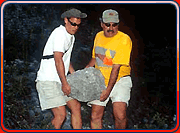
Ed and a scientist collect a boulder for the Hall of Planet Earth.
7. What was your most difficult expedition?
Ed: Collecting rocks from the bottom of the ocean was a difficult but amazing experience.
Our goal was to collect deep sea vents , which are formed along mid-ocean ridges at the bottom of the ocean. No one had ever done this before. Our plan was to go more than 2,100 meters (7,000 feet) below the surface of the ocean to the Juan de Fuca Ridge, which is off the coast of Washington State.
First, we took a three-week boat trip to do research and make a plan for collecting the vents. The following year we returned to collect them. The team stayed on the ship at the surface to direct the remotely controlled vehicle as it went down to the bottom of the ocean.
It was very complicated, and we didn't know if we could do it. But we did! And now these amazing rocks are in the Museum for everyone to see.
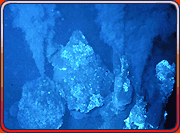
Deep-sea vents spew hot, mineral-rich water into the ocean.
8. Have you ever seen a volcano erupt?
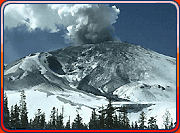
Mount St. Helens, Washington
Ed: Yes, I've been on many active volcanoes . Those are volcanoes that can still erupt.
One of the most amazing volcanic eruptions I've ever seen was Mount St. Helens near Seattle, Washington. In 1981, this volcano erupted and destroyed half the mountain.
Before it erupted, many geologists were fascinated that Mount St. Helens was literally growing. Previous eruptions of magma, or melted rock, had formed the tall mountain. Magma was again rising towards the top, and this was causing the mountain to bulge. There was also steam coming out of the top and small ash eruptions, so it was no surprise when the big eruption happened.
I was sailing close to Seattle that day when I heard the explosion. It made a very loud boom. I didn't know that it had erupted until later, when we could see the plume of smoke. Very few people had seen an eruption this strong before.
9. What do you think Earth would look like in 4 million years? In 4 billion years?
Ed: In 4 million years, Earth would not look very different from how it does today. The same mountains would exist, and we would still have the same four oceans. The climate would be close to what it is right now. Geologists call the last 2.5 million years an ice age, with Earth's climate slowly cooling, so we would still be in this same period. The continents would change position slightly, but not much.
Earth has been around for 4.5 billion years, so 4 million years is not very much time.
But 4 billion years from now is a different story. Perhaps this planet would look like Venus , which has nothing living on it and has a surface temperature of 460°C (860°F). It's hard to say ...
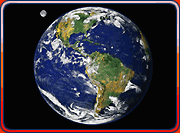
The Earth is a dynamic, living planet.
10. Is Earth always changing?
Ed: Earth is changing constantly. Some changes happen quickly and are easy to see. An earthquake can change the landscape of a city in a few seconds. A sandstorm can cover a large area with sand in a few hours. A hurricane can destroy a beach or town in a few hours.
Most changes occur very, very slowly, so you can't see them all. For example, North American and Africa were once joined together as part of the supercontinent Pangaea. Pangaea separated into smaller continents about 200 million years ago with the opening of the Atlantic and Indian oceans. Africa and North America have been moving away from each other at the rate of 2.5 centimeters (1 inch) per year. That's how fast your fingernails grow! The surface of Earth is always changing in so many ways that we can't see.
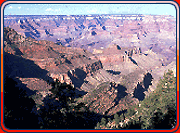
Erosion by water and wind help form the Grand Canyon.
11. Do you think that there's another planet just like ours?
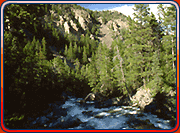
Earth is a special place. It has all the things we need to live.
Ed: There are no planets in our solar system like Earth. Earth is unique. It has all the things we need to live, such as liquid water, protection from the harmful radiation from our light-giving Sun , and oxygen to breathe.
Some people think there must be another planet like Earth out there somewhere because there are so many planets. We've discovered more than 100 planets around the nearest stars and more are being discovered all the time.
Earth is a very unusual and special planet. Perhaps there's another planet somewhere that's like Earth, but there cannot be very many of them.
12. Do you think one day we will travel to the center of Earth?
Ed: No, because the center of Earth is perhaps 6,000°C (10,832°F) in the very center. This is as hot as the surface of the Sun. The pressure is also far greater than we can stand and would crush us.
It's about 6,000 kilometers (3,700 miles) to the center of Earth. Humans have only gone about 4 kilometers (2.5 miles) deep into Earth, and machines have only gone about 12 kilometers (7.5 miles).
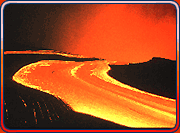
The center of Earth is eight times hotter than lava.
13. Can I make a rock?
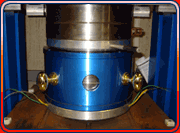
Scientists use a machine called the "Big Blue" to make rocks in the lab.
Ed: It is possible to make rocks, but you need very special, expensive equipment to do it.
Rocks are made of minerals. Different rocks have different kinds of minerals or different amounts of the same minerals. Rocks have different colors because the minerals they are made from have different colors.
Some geologists study rocks by actually making them in a laboratory. They heat the starting material, which is often ground-up or powdered minerals, to very high temperatures to melt them, or they apply high pressure to change them. This makes the minerals come together as rocks.
But there are some rocks that are easy to make. A hunk of ice, for example, is made up of different ice crystals and is considered a rock. All you have to do to make this rock is put water in a freezer.
14. Do all rocks come from volcanoes?
Ed: No, there are many rocks that don't come from volcanoes.
For example, some rocks are created when sediments are deposited in water. Sediments can be sand or silt, which are fine grains of minerals. This might occur along the beach, or at the mouths of streams and rivers. Over time, more and more silt and sand accumulate, eventually forming a thick pile.
Because of the great weight of the thick layer of sediments, water is driven out. The loose grains of sediment join together to form a rock.
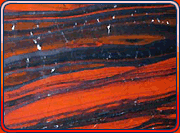
This sedimentary rock has layers of iron-rich minerals.
15. What are some of the best places in the world to study rocks?
Ed: I think you can study rocks almost everywhere. There's no shortage of rocks. So it really depends on what are your favorite places to go to and what type of rocks you want to find.
Some people like to study in rocks on the ocean floor; other people like to study rocks in mountains. Some people like to study rocks in Central Park in New York City; other people like to go to the country.
Some people are interested in studying rocks that were once sediments and deposited by water. Those rocks tell us a lot about the environment when the sediments were formed. Other people like to study rocks that were once deep in mountains but are now sticking out or exposed on Earth's surface. These rocks can tell you how the mountains formed.
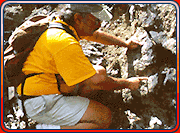
Ed examines rocks on a cliff.
16. How do you identify the rocks that you find?
Ed: Some rocks are easy to identify. For example, sandstone is made of little tiny grains of sand all stuck together. It's pretty easy to spot a sandstone. Lavas are usually easy to identify. They have very, very fine grains, they may have bubbles in them, and they may have surface textures that suggest that they were liquid at one time. Granites are easy rocks to identify, too, because the mineral grains in them are large and easy to see.
But there are many rocks that are difficult to identify, especially rocks that have experienced stress from high pressures and high temperatures and have changed due to those conditions. Sometimes even geologists have difficulties identifying rocks. We use microscopes and chemical tests to show us what we can't see with our eyes.
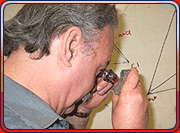
Ed looks closely at the fine grains of a rock.
17. How do kids start a rock collection?
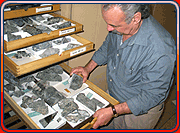
Ed shows us the Museum's rock collection.
Ed: It's easy to start a rock collection. All you need is rocks, and rocks are almost everywhere.
You should look for different kinds of rocks for your rock collection. That means you'll have to get someone to take you to different places.
You can collect rocks that have different colors and different textures. As you collect your rocks, a great thing to do is to try to figure out whether your rock is an igneous rock , a sedimentary rock , or a metamorphic rock .
Each rock is unique and holds clues to the distant past.
Image Credits:
Photos: Ed Mathez: courtesy of AMNH; Montana mountains: NPS; rocks: courtesy of AMNH; Ed in Greenland: courtesy of AMNH, Ed Mathez; Ed looking over defunct chromitemine: courtesy of AMNH, Denis Finnin; collecting boulder: courtesy of AMNH, Denis Finnin; deep sea vents: Dr. Michael Perfit, University of Florida, and NOAA VENTS Program; Mount St. Helens: USGS; Earth: NASA/JPL; Grand Canyon: courtesy of AMNH; Stillwater mine: courtesy of AMNH, Denis Finnin; lava: NOAA; big blue machine: courtesy of AMNH, Rondi Davies; banded iron: courtesy of AMNH; Ed examining chromitite: courtesy of AMNH, Denis Finnin; Ed examining rock and in the collection: courtesy of AMNH; Illustrations: recycling bin: courtesy of AMNH




 Biodiversity
Biodiversity
 Brain
Brain
 Genetics
Genetics
 Marine BiOLogy
Marine BiOLogy
 MicrobiOLogy
MicrobiOLogy
 PaleontOLogy
PaleontOLogy
 ZoOLogy
ZoOLogy
 AnthropOLogy
AnthropOLogy
 ArchaeOLogy
ArchaeOLogy
 Astronomy
Astronomy
 Climate Change
Climate Change
 Earth
Earth
 Physics
Physics
 Water
Water
